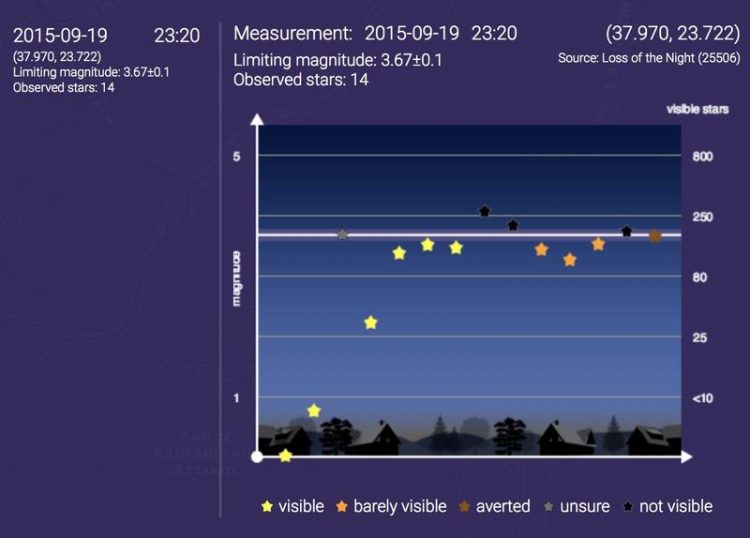Our sky, our observations, our data: new project puts open data back into the hands of citizens

On this screenshot the data of a user’s entire “Loss of the Night” app observation is displayed. You can see which stars the participant was able to see. myskyatnight.com
Christopher Kyba is a researcher at the GFZ German Research Centre for Geosciences and the Leibniz-Institute of Freshwater Ecology and Inland Fisheries (IGB). He studies light pollution – too much light at the wrong time and place. He initiated the “Loss of the Night” app project in 2013, where citizen scientists from around the world send in their observations of sky brightness by determining the number of visible stars in the night sky.
“The data from these observations are crucial for our science. We urgently need them to evaluate how skyglow is changing worldwide”, says Kyba. This research cannot be done with satellites, because they measure the light emitted upward, not the light experienced on the ground by humans and other living creatures.
A further complication is that the current satellites are not sensitive to the blue part of the visible spectrum. So far, only professional scientists have analyzed the skyglow data taken by citizen scientists. Kyba wanted to change that, and put the data and tools to analyze it back into the hands of the public.
Citizen science on a new level
Together with the company Interactive Scape GmbH in Berlin (www.interactive-scape.com), Kyba developed the web-based application “myskyatnight.com”.
The data from the “Loss of the Night” app and two other citizen science projects on light pollution are freely available there. Citizen scientists can easily navigate, view, and download the data, and perform their own analyses directly on the site. Users of the “Loss of the Night” app can also create a profile to easily view their own data.
Kyba hopes that giving citizen scientists access to the data will increase their motivation to participate in taking data: “With the new web application, it’s easy to see that the best results come when citizen scientists make multiple observations from the same location each year”.
The scientists also hope that the data will eventually feed back into local decisions about outdoor lighting. “In the ideal case, we will find examples of success stories: cities that invest in environmentally friendly lighting and end up seeing more stars above well-lit sidewalks”.
The project was funded by the European Commission within the MYGEOSS program, which aims to develop smart Internet applications informing European citizens on the changes affecting their local environment. The new website “myskyatnight.com” became available on 3 December 2015.
Website of the project: http://www.myskyatnight.com
Contact:
Dr. Christopher Kyba
Deutsches GeoForschungsZentrum, Potsdam and
Leibniz-Institute of Freshwater Ecology and Inland Fisheries (IGB), Berlin
Telephone: +49 (0)331 288 28973
Email: kyba@gfz-potsdam.de
Nadja Neumann/Angelina Tittmann
Public Relations
Leibniz-Institute of Freshwater Ecology and Inland Fisheries (IGB)
Telephone: +49 (0)30 64181 -975/-631
Email: pr@igb-berlin.de
About Leibniz-IGB:
The Leibniz-Institute of Freshwater Ecology and Inland Fisheries, IGB, is an independent and interdisciplinary research centre dedicated to the creation, dissemination, and application of knowledge about freshwater ecosystems. Working in close partnership with the scientific community, government agencies, as well as the private sector, guarantees the development of innovative solutions to the most pressing challenges facing freshwater ecosystems and human societies.
Media Contact
All latest news from the category: Earth Sciences
Earth Sciences (also referred to as Geosciences), which deals with basic issues surrounding our planet, plays a vital role in the area of energy and raw materials supply.
Earth Sciences comprises subjects such as geology, geography, geological informatics, paleontology, mineralogy, petrography, crystallography, geophysics, geodesy, glaciology, cartography, photogrammetry, meteorology and seismology, early-warning systems, earthquake research and polar research.
Newest articles

A ‘language’ for ML models to predict nanopore properties
A large number of 2D materials like graphene can have nanopores – small holes formed by missing atoms through which foreign substances can pass. The properties of these nanopores dictate many…

Clinically validated, wearable ultrasound patch
… for continuous blood pressure monitoring. A team of researchers at the University of California San Diego has developed a new and improved wearable ultrasound patch for continuous and noninvasive…

A new puzzle piece for string theory research
Dr. Ksenia Fedosova from the Cluster of Excellence Mathematics Münster, along with an international research team, has proven a conjecture in string theory that physicists had proposed regarding certain equations….



